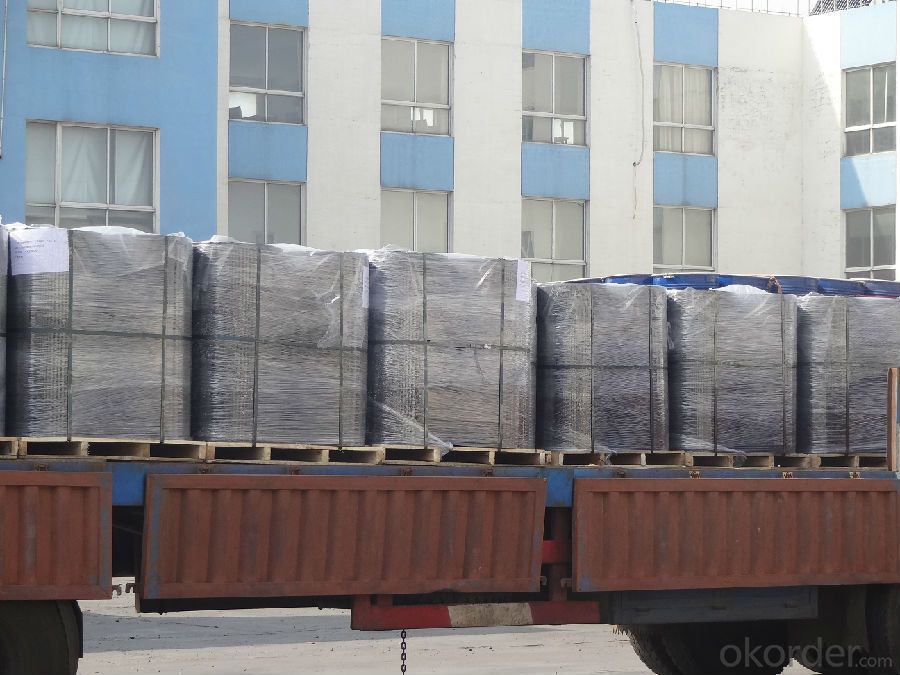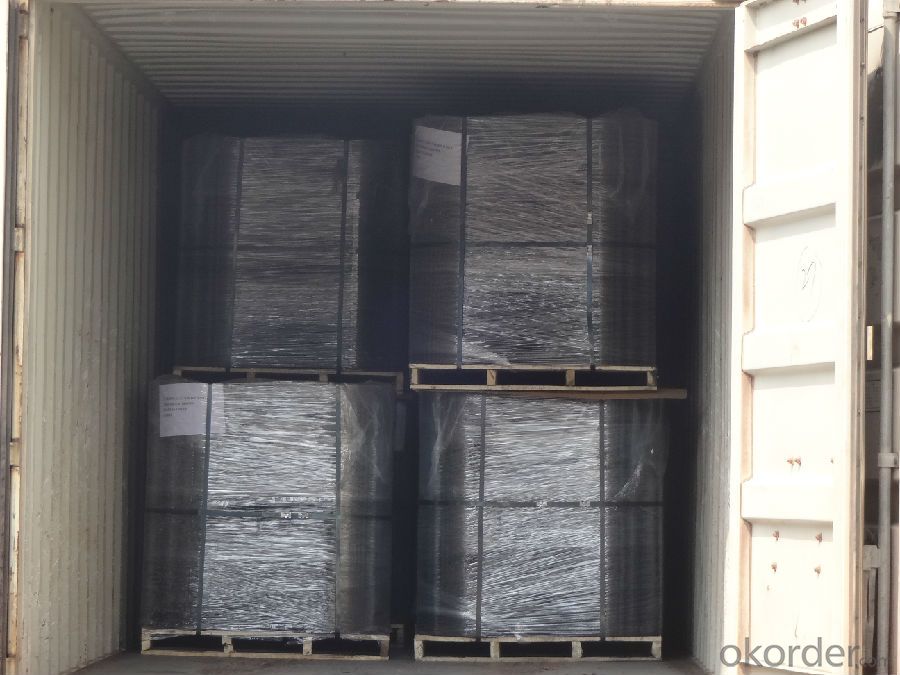cylinder Carbon Electrode Paste with low Ash
- Loading Port:
- Lianyungang
- Payment Terms:
- TT OR LC
- Min Order Qty:
- 20 m.t.
- Supply Capability:
- 800 m.t./month
OKorder Service Pledge
OKorder Financial Service
You Might Also Like
Spcifications
1:carbon eletrode paste
2:for ferroalloy,calcium carbide manufacture
3:HS 3801300000,YB/T5212-1996,ISO9001:2008
Product Description
Carbon Electrode Paste is a self-baking electrode used in submerged arc furnaces for delivering power to the charge mix. Electrode Paste is added to the top of the electrode column in either cylindrical or briquette form. As the paste moves down the electrode column the temperature increase causes the paste to melt and subsequently bake forming a block of electrically conductive carbon. Electrode Paste is essentially a mix of Electrically Calcined Anthracite (ECA) or Calcined Petroleum Coke (CPC) with Coal Tar Pitch.
Graphite/Carbon Electrode Paste Specification:
| PARAMETER UNIT GUARANTEE VALUE | ||||||
| Ash.( % ) | 4.0 max | 5.0 max | 6.0 max | 7.0 max | 9.0 max | 11.0 max |
| V.M (%) | 12.0-15.5 | 12.0-15.5 | 12.0-15.5 | 9.5-13.5 | 11.5-15.5 | 11.5-15.5 |
| Compress Strength. | 18.0 min | 17.0 min | 15.7 min | 19.6 min | 19.6 min | 19.6 min |
| Specific Resistance | 65 max | 68 max | 75 max | 80 max | 90 max | 90 max |
| Bulk Density | 1.38 min | 1.38 min | 1.38 min | 1.38 min | 1.38 min | 1.38 min |
Picture:


- Q:The printed document will be marked on the document name: carbon copy, no combination number, two links...... What's the meaning of this? What is the connection between the infinite and the two? I MMM
- [2] (Printing Graphic, Arts printing, also use Graphic Communications graphics communication) is the text, pictures, photos, etc. the application of anti-counterfeiting ink, pressure plate, etc., so that the ink transferred to the surface of paper, textiles, plastic products, leather and other materials, bulk copy the content of technology.
- Q:What's the difference between coal and carbon?
- Difference can be big, one is coal, one is carbon, at least the price is not the same
- Q:How does carbon impact the availability of clean water resources?
- Carbon can have a significant impact on the availability of clean water resources. One of the main ways carbon affects water resources is through its contribution to climate change. Increased carbon emissions, mainly from the burning of fossil fuels, lead to higher global temperatures and disrupt the water cycle. As a result, some regions may experience more frequent and severe droughts, while others face increased rainfall and flooding events. Climate change also affects the melting of glaciers and snowpacks, which are crucial sources of freshwater for many communities. As carbon emissions warm the planet, glaciers and snowpacks melt at an accelerated rate, leading to reduced water supply in rivers and streams that rely on this natural storage. This can ultimately result in water scarcity and affect not only drinking water availability but also agricultural irrigation and industrial water usage. Furthermore, carbon pollution can also impact the quality of water resources. Carbon dioxide dissolves in water and reacts with it, leading to a decrease in pH levels and increased acidity. This phenomenon, known as ocean acidification, is particularly harmful to marine ecosystems and organisms that rely on carbonate ions to build their shells or skeletons. As these organisms struggle to survive, it can disrupt the balance of entire aquatic ecosystems, which in turn affects the availability of clean water resources. Moreover, carbon-based pollutants from human activities, such as industrial processes or agricultural runoff, can contaminate water sources. For example, carbon-based chemicals like pesticides, fertilizers, and hydrocarbons can infiltrate groundwater or get washed into rivers and lakes, compromising their quality and making them unsuitable for drinking or other uses. Overall, the impact of carbon on the availability of clean water resources is multifaceted. It affects the quantity of water through changes in the water cycle, reduces the quality of water through acidification and pollution, and disrupts ecosystems that rely on water resources. Addressing carbon emissions and mitigating climate change is crucial to protect and ensure the availability of clean water for present and future generations.
- Q:How is carbon involved in the metabolism of carbohydrates, proteins, and fats?
- The metabolism of carbohydrates, proteins, and fats relies heavily on carbon, a fundamental element. Within all three macronutrients, carbon atoms play a vital role in forming their molecular structures. Carbohydrates contain carbon in the form of glucose, which serves as the body's primary energy source. Through glycolysis, glucose is broken down into smaller molecules, generating ATP for cellular energy. Carbon atoms in glucose are rearranged and converted into intermediate compounds, which are further utilized in other metabolic pathways. In contrast, proteins are intricate molecules made up of amino acids, each containing a carbon atom. During protein metabolism, carbon atoms participate in various reactions, including deamination and transamination, enabling the synthesis or breakdown of proteins. Carbon atoms also contribute to the formation of peptide bonds, linking amino acids together to create the backbone of proteins. In the metabolism of fats or lipids, carbon is predominantly found in the fatty acid chains. These chains provide a high-energy fuel source, as they can be broken down through beta-oxidation. Sequential cleavage of carbon atoms from fatty acids produces acetyl-CoA, which enters the citric acid cycle (also known as the Krebs cycle) to generate ATP. Furthermore, carbon atoms from fatty acids can be utilized for the synthesis of other molecules, such as cholesterol and hormones. In summary, carbon plays a crucial role in the metabolism of carbohydrates, proteins, and fats. Its involvement in these metabolic processes facilitates energy production, the synthesis and breakdown of essential molecules, and the regulation of various physiological functions.
- Q:How is carbon used in the steel industry?
- Carbon is used in the steel industry as an essential element for the production of steel. It is added to iron during the steelmaking process to increase the strength and hardness of the final product. By controlling the carbon content, different types of steel with varying properties can be produced, such as high carbon steel for tools or low carbon steel for structural applications.
- Q:How do fossil fuels release carbon dioxide when burned?
- When fossil fuels are burned, the carbon atoms present in them combine with oxygen from the air, resulting in the release of carbon dioxide (CO2). This process, known as combustion, produces energy and water vapor as byproducts.
- Q:What is the carbon content of different types of rocks?
- The carbon content of different rock types can vary greatly, with rocks primarily consisting of minerals that do not contain much carbon. However, certain rocks can have varying amounts of carbon due to the presence of organic matter or other carbon-rich materials. Sedimentary rocks, like limestone and coal, have the potential to contain higher levels of carbon. Limestone is mainly made up of calcium carbonate, but it can also have small amounts of organic matter or carbonates that contribute to its carbon content. In contrast, coal is a sedimentary rock formed from decomposed and carbonized plant material, resulting in a high carbon content ranging from 50% to 90%. Igneous rocks, formed from solidified molten material, generally have very low carbon content because the process of magma crystallization does not involve the inclusion of carbon-rich materials. However, there are exceptions in certain cases where magma interacts with carbon-rich fluids or rocks, leading to the formation of carbon-bearing minerals like graphite or diamond. Metamorphic rocks, formed through the transformation of existing rocks under high pressure and temperature, may contain varying amounts of carbon. The carbon in metamorphic rocks can come from the original rock or be introduced during the metamorphism process. For example, carbonaceous material in shale or limestone can be converted into graphite or other carbon-rich minerals during metamorphism. It is important to note that although some rocks may have significant carbon content, they are not considered a major reservoir of carbon in the Earth's carbon cycle. The majority of carbon is stored in the atmosphere as carbon dioxide, in the oceans, or in organic matter within living organisms.
- Q:What are the sources of carbon emissions?
- The sources of carbon emissions include burning fossil fuels (such as coal, oil, and natural gas) for electricity, transportation, and industrial processes, as well as deforestation and land-use changes.
- Q:What are the alternatives to fossil fuels for energy production?
- Renewable energy sources such as solar, wind, hydroelectric, geothermal, and biomass are considered as alternatives to fossil fuels for energy production. These sources provide a sustainable and cleaner option, as they do not contribute to greenhouse gas emissions and are replenishable.
- Q:What are the consequences of increased carbon emissions on public health systems?
- Increased carbon emissions have significant consequences on public health systems. As carbon dioxide levels rise, so does the concentration of air pollutants such as particulate matter, ozone, and nitrogen dioxide. These pollutants have been linked to a range of respiratory and cardiovascular problems, including asthma, lung cancer, and heart disease. Additionally, climate change resulting from increased carbon emissions can contribute to the spread of infectious diseases, heat-related illnesses, and mental health issues. These impacts place a substantial burden on healthcare systems, leading to increased healthcare costs and strained resources.
1. Manufacturer Overview |
|
|---|---|
| Location | |
| Year Established | |
| Annual Output Value | |
| Main Markets | |
| Company Certifications | |
2. Manufacturer Certificates |
|
|---|---|
| a) Certification Name | |
| Range | |
| Reference | |
| Validity Period | |
3. Manufacturer Capability |
|
|---|---|
| a)Trade Capacity | |
| Nearest Port | |
| Export Percentage | |
| No.of Employees in Trade Department | |
| Language Spoken: | |
| b)Factory Information | |
| Factory Size: | |
| No. of Production Lines | |
| Contract Manufacturing | |
| Product Price Range | |
Send your message to us
cylinder Carbon Electrode Paste with low Ash
- Loading Port:
- Lianyungang
- Payment Terms:
- TT OR LC
- Min Order Qty:
- 20 m.t.
- Supply Capability:
- 800 m.t./month
OKorder Service Pledge
OKorder Financial Service
Similar products
New products
Hot products
Related keywords



























